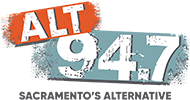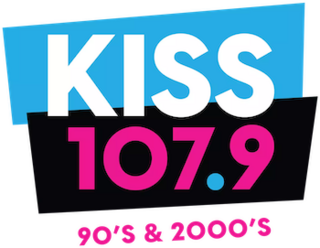Related Research Articles
WFIU is a public radio station broadcasting from Indiana University Bloomington (IUB) in Bloomington, Indiana, United States. The station is a member station of NPR, Public Radio International and American Public Media. Together with IUB-owned television station WTIU, it is known as Indiana Public Media. Studios are located in the Radio-Television Building on the IUB campus, and the transmitter is located at a site on South Sare Road in Bloomington. Seven translators broadcast WFIU and its second HD Radio subchannel, primarily in areas outside of the main transmitter's coverage area, including Terre Haute and Kokomo.

KDND (107.9 MHz) was an FM radio station licensed to Sacramento, California, United States. The station first signed on in 1947 as KXOA-FM, an FM simulcast of AM station KXOA, before separating itself with distinct programming, including most prominently soft rock, adult contemporary, and classic hits formats. In July 1998, two years after the sale of the station to Entercom, the station switched to its final KDND call letters and contemporary hit radio format branded as 107.9 The End. At the time of the station's closing, KDND's studios were located in North Highlands, while its transmitter was located just north of the Sacramento city limits near Elverta.

KSEG is a commercial FM radio station in Sacramento, California. It airs a classic rock radio format and is owned by Audacy, Inc. The studios and offices are located on Madison Avenue in North Highlands. KSEG is co-owned with five other Sacramento Audacy radio stations.

WXYT-FM is a commercial radio station in Detroit, Michigan, serving Metro Detroit and much of Southeast Michigan. It airs a sports radio format and is owned by Audacy, Inc. Its studios and offices are located in the nearby suburb of Southfield.
KCVV is an AM radio station in Sacramento, California. It is owned by the Roman Catholic Diocese of Sacramento and airs a Spanish language Catholic radio format. English language Catholic programming is heard on KSMH in West Sacramento.

KKDO is a commercial radio station licensed to Fair Oaks, California, and serving the Sacramento metropolitan area radio market. The station is branded "Alt 94-7" and it programs an alternative rock radio format. The Audacy, Inc. outlet has its transmitter off Rosebud Lane in Citrus Heights. Its studios are located in North Highlands.
KUAC is a non-commercial FM radio station in Fairbanks, Alaska, broadcasting at 89.9 MHz. The station is operated by the University of Alaska Fairbanks. It debuted on October 2, 1962, originally at 104.9 MHz, as Alaska's first non-commercial radio station and second FM station.

KRVM-FM (91.9 MHz) is a community radio station in Eugene, Oregon, United States. KRVM's primary programming is available via online streaming, with listener-supporters located around the world. The station license and studio facility are owned by Eugene School District 4J, but the school district provides no direct funding to the station; all funding comes from listener supporters, business underwriters, and the Corporation For Public Broadcasting. The main studio is located at Sheldon High School, with a satellite studio at Spencer Butte Middle School.
KXPR is a non-commercial, listener-supported public radio station in Sacramento, California, airing a classical music format. Along with sister station KXJZ 90.9 FM, they are known as Capital Public Radio or "CapRadio." Both stations are owned by California State University, Sacramento, and share studios along Folsom Boulevard on campus.

WGTS is a non-commercial, FM radio station licensed to Takoma Park, Maryland. The station is licensed to and owned by Atlantic Gateway Communications Inc. It broadcasts a Christian adult contemporary music format. Its studios are in Rockville, Maryland, and its broadcast tower is located near Arlington, Virginia, and it operates a repeater service, WGBZ, near Ocean City, Maryland. The station call letters echo Washington Adventist University's motto: Washington's "Gateway To Service".
WMIT is a non-profit FM radio station licensed to Black Mountain, North Carolina.
WFOS is a non-commercial, listener-supported, public radio station licensed to Chesapeake, Virginia, and serving the Southside of Hampton Roads. WFOS is owned by Hampton Roads Educational Telecommunications Association. Its format includes oldies, Motown, adult standards and other past musical styles.
North State Public Radio is an NPR-affiliated public radio broadcaster which has main stations in the Northern California cities of Redding and Chico. It airs news and public affairs, classical music, talk radio and jazz programs. With the help of a number of relay transmitters, NSPR's signal covers a large portion of the North State region, including the cities of Red Bluff, Oroville, Paradise, Anderson, and Shasta Lake City.
KUOP is an NPR-member radio station, licensed to Stockton, California, United States. The station is currently owned by California State University, Sacramento and is part of the news network of CapRadio.

KUNR and KNCC are non-commercial, listener-supported public radio stations. KUNR is licensed to Reno, Nevada, and KNCC is licensed to Elko, Nevada. Owned and operated by the University of Nevada, Reno, they simulcast a news and information radio format and are members of National Public Radio (NPR). The studios and offices are on North Virginia Street in Reno, on the university campus.

Pilgrim Radio is a network of radio stations broadcasting a Christian radio format. Pilgrim Radio's programming includes interviews with Christian leaders, discussion of current events/issues, news, a book-reading program, and teaching messages, along with Christian contemporary music. Pilgrim Radio is listener-supported and commercial-free.

WKQQ is a radio station licensed to the city of Winchester, Kentucky, serving Lexington and the greater Central Kentucky area. The station is owned by iHeartMedia and airs a classic rock format.
CapRadio is the public radio service of California State University, Sacramento. It consists of two full-power stations and five repeaters, all members of National Public Radio. It is the NPR member for Sacramento and much of the surrounding area, including Stockton and Modesto.

KZIS is a radio station in Sacramento, California, United States. It is owned and operated by iHeartMedia, broadcasting from the iHeartMedia studio center in North Sacramento and a tower north of the city near Elverta, also used by KXPR and KQEI-FM. The station is broadcasting a hot adult contemporary format focusing on hits of the 1990s and 2000s as "Kiss 107.9".
References
- ↑ "Facility Technical Data for KXJZ". Licensing and Management System. Federal Communications Commission.
- ↑ Radio-Locator.com/KXJZ
- ↑ "Sacramento HD radio guide". Archived from the original on July 13, 2011. Retrieved May 24, 2008.
- 1 2 3 "SSC Slates Educational, Cultural Broadcasts". Sacramento Bee. October 4, 1964. p. B5. Retrieved March 24, 2020– via Newspapers.com.
- 1 2 3 4 "History Cards for KXJZ". Federal Communications Commission. (Guide to reading History Cards)
- ↑ "SSC Radio Station Hikes Range Up To 50 Miles". Sacramento Bee. April 25, 1968. p. C1. Retrieved March 24, 2020– via Newspapers.com.
- ↑ "SSC Radio Station Will Get Stronger Voice". Sacramento Bee. September 17, 1967. p. B4. Retrieved March 24, 2020– via Newspapers.com.
- ↑ Huber, Dean (June 9, 1968). "SSC's Radio Station Increases Power, Reaching More Of Public While Teaching". Sacramento Bee. Retrieved March 24, 2020– via Newspapers.com.
- ↑ "Campus News" (PDF). Billboard. June 26, 1971. p. 34. Retrieved March 24, 2020.
- ↑ Williams, George (May 7, 1971). "'No Tax' Probe Gets 'No Talk' Reply From Rose King". Sacramento Bee. pp. B1, B3 . Retrieved March 24, 2020– via Newspapers.com.
- ↑ "Reagan's 'Revealer' Is Lauded". Sacramento Bee. Associated Press. May 9, 1971. p. B1. Retrieved March 24, 2020– via Newspapers.com.
- ↑ "League Of Bay Area Mayors". Sacramento Bee. March 1, 1981. p. A3. Retrieved March 24, 2020– via Newspapers.com.
- ↑ "Hamburg names campaign team". The Ukiah Daily Journal. March 7, 1992. p. 8. Retrieved March 24, 2020– via Newspapers.com.
- ↑ Hurst, John V. (March 18, 1978). "Public Radio Station Nears For Sacramento". Sacramento Bee. p. B3. Retrieved March 24, 2020– via Newspapers.com.
- ↑ "KERS-FM Wins Grant, Plans To Become Public Station". Sacramento Bee. September 28, 1977. p. D3. Retrieved March 24, 2020– via Newspapers.com.
- ↑ "KERS, With Federal Grant, Expands Broadcast Hours". Sacramento Bee. December 17, 1977. p. A8. Retrieved March 24, 2020– via Newspapers.com.
- 1 2 Tracy, Dick (December 27, 1978). "Sweeter Classical FM Music Is Due In 1979". Sacramento Bee. pp. C1, C8 . Retrieved March 24, 2020– via Newspapers.com.
- 1 2 Hooks, Kris (April 14, 2016). "KSSU celebrates 25 years as Sac State's scrappy student-run radio station". News Review. Retrieved March 24, 2020.
- ↑ Huber, Dean (July 29, 1978). "In Focus". Sacramento Bee. p. E6. Retrieved March 24, 2020– via Newspapers.com.
- ↑ Tracy, Dick (March 24, 1979). "Birth Of Public Radio In Capital". p. A11. Retrieved March 24, 2020– via Newspapers.com.
- ↑ Tracy, Dick (October 21, 1981). "KXPR Public Radio 'Suffers' From Growing Pains". Sacramento Bee. p. B13. Retrieved March 24, 2020– via Newspapers.com.
- ↑ Tracy, Dick (July 6, 1983). "National Public Radio Will Face An Uncertain Future". Sacramento Bee. p. D3. Retrieved March 24, 2020– via Newspapers.com.
- 1 2 3 4 5 6 "History". Capital Public Radio. Archived from the original on August 16, 2000. Retrieved March 24, 2020. (Note that, like a slew of official sources, this misstates KERS's sign-on as 1970, not 1964.)
- ↑ Tracy, Dick (November 14, 1984). "Are women still just second-string players on the air?". Sacramento Bee. p. E6. Retrieved March 24, 2020– via Newspapers.com.
- 1 2 3 "CapRadio to move downtown after a long run at Sac State". CSU Sacramento. May 6, 2019. Retrieved March 24, 2020.
- ↑ "New and blue". Sacramento Bee. July 2, 1991. p. B6. Retrieved March 24, 2020– via Newspapers.com.
- ↑ Graswich, R.E. "Time's running out on Steinberg's deal to help Maloofs in arena talks". Sacramento Bee. p. B1. Retrieved March 24, 2020– via Newspapers.com.
- ↑ McManis, Sam (September 4, 2006). "A classical numbers game". Sacramento Bee. pp. E1, E8 . Retrieved March 24, 2020– via Newspapers.com.
- ↑ McManis, Sam (June 2, 2006). "Public radio exec departs". Sacramento Bee. pp. D1, D2 . Retrieved March 24, 2020– via Newspapers.com.
- ↑ InsideRadio.com "CapRadio" Aug. 31, 2023. Retrieved Sept. 15, 2023.
- ↑ "Capital Public Radio Coverage Map" (PDF). capradio.org. April 13, 2016. Retrieved July 22, 2017.